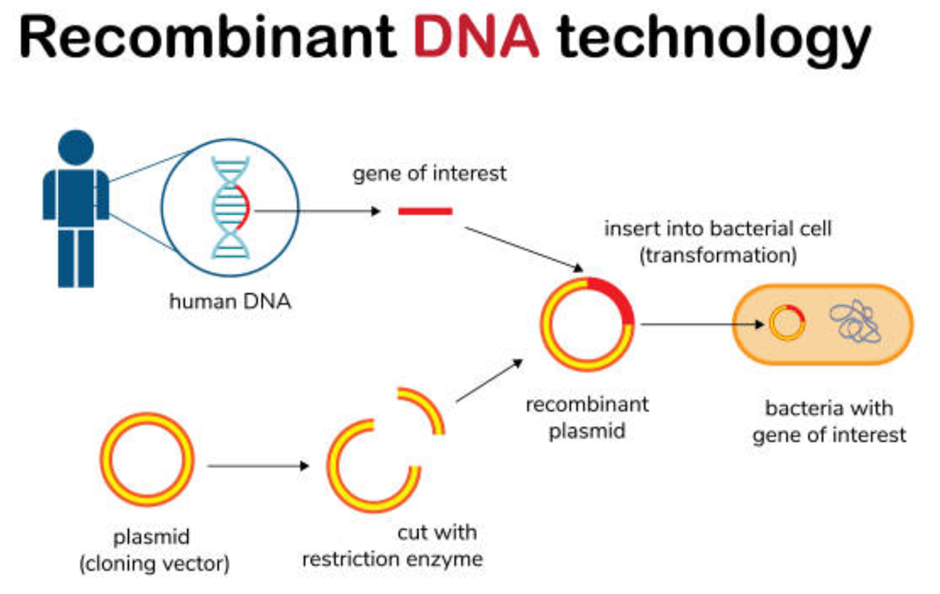(toc)
Explanation:
The r-DNA technology is known as recombinant-DNA technology. It involves the combining of different DNA molecules from different species and inserting them into a host to produce a new variety of species that do not exist naturally.
Method or Procedure:
The steps included in forming a r-DNA are DNA isolation, selection of vector, cloning of gene, Transformation and Selection after observing the gene expression.
❖ DNA isolation:
The DNA of interest is isolated from the living organism with the help of enzymes such as Restriction Endonucleases.
❖ Selection of vector:
The second step involves the selection of suitable vectors to deliver the DNA of interest into the host species.
❖ Cloning of gene:
The DNA of interest is combined with the suitable vector to form a r-DNA
❖ Transformation:
The r-DNA thus formed is delivered to the host organisms like yeast, bacteria etc.,
❖ Selection after observing the gene expression:
The inserted DNA of interest is used to produce a desired protein in the host cell and it is selected soon after its expression of the gene to form a protein of interest.
Advantages:
The r-DNA technology is useful in various fields of science. Some of them include:
★ Medical therapeutics
★ Rearing crops
★ Benefits in technical domain and ecosystem
★ Innovative ideas in the invention and research
★ Medical therapeutics:
This r-DNA technology is used to produce vaccines in a recombinant manner and medicines. It is used to manipulate the genes to form new proteins, to deliver the drug to its target and to diagnose a disease.
➢ Production of recombinant vaccines:
It is used for the production of vaccines to treat various diseases by following the safety precautions. It happens by inserting the non-virulent form of antigens into the host species like yeast, bacteria etc.,
➢ Pharmaceutical production:
This technology is used to produce numerous therapeutic proteins such as growth hormones, insulin, antibodies and clotting factors for treating various diseases.
➢ Gene manipulation:
It involves the repair or replacement of the defective genes with the normal functioning genes to cure various genetic disorders.
➢ Delivery of the drug to its target:
This technology involves the delivery of the drug to the infected cells or tissues for the improvement of the efficacy of the medical treatment and its reduction in side effects.
➢ Disease diagnosis:
It is used to produce r-DNA based diagnostic devices which in turn is used for the accurate and early detection of disorders and diseases.
★ Rearing crops:
This technology is used to uplift the yield of the desired crops, to produce environmental stress and herbicide tolerant, and disease and pest resistant crops.
➢ Upliftment in the yield of the desired crops:
It is involved in the upliftment of the quantity of the desired crops as per the norms of the food safety concerns.
➢ Production of environmental stress tolerant crops:
This technology is used to produce crops that can tolerate the environmental stress conditions like extreme temperatures, drought and salinity,
➢ Production of herbicide tolerant crops:
It is used to produce crops that are resistant to certain herbicides, thereby promoting the control of weeds and reduction in the use of herbicides.
➢ Production of disease and pest resistant crops:
This technology is used to produce crops that are resistant to several diseases and pests which in turn reduces the use of pesticides.
★ Benefits in technical domain and ecosystem:
It is used to produce plastics which are biodegradable, enzymes used in the industries and in the bioremediation.
➢ Production of plastics that are biodegradable:
It is used to produce plastics which are easily degraded by the ecosystem, promoting the use of eco-friendly products.
➢ Production of enzymes in the industries:
It is used to produce enzymes that are involved in the industrial processes like manufacturing of detergents, production of biofuel and processing of foods.
➢ Bioremediation:
This technology is used in the process of forming recombinant microbes that are used to clean oil spills, certain pollutants etc.,
★ Innovative ideas in the invention and research:
This technology is used to produce certain models to study the diseases and also to explore various gene functions.
➢ Production of disease models:
It is used to develop models of diseases such as mice to understand the mechanisms of diseases and for testing potential therapies.
➢ Exploration of various gene functions:
It is used to analyze and study the functions of various genes, its interactions and regulations.
Disadvantages:
Although, there are numerous advantages in the use of this technology, the disadvantages are also not lesser. Some of them include:
★ The cost involved in this technology is huge.
★ The techniques are very complex.
★ The misuse of certain hazardous genes could lead to the development of certain biological weapons that are extremely harmful.
★ It is not suitable for all genetic disorders especially for those that are with complex and poly-gene interactions.
★ As this technology is solely artificial, it might cause some vulnerable damages to the natural ecosystem by means of forming clones of the pathogens, gene pollution and so on



